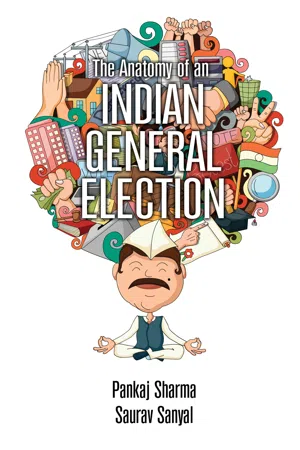
- English
- ePUB (mobile friendly)
- Available on iOS & Android
The Anatomy of an Indian General Election
About This Book
Anatomy of Indian General Elections is the concluding part of Trilogy on 2019 Elections. The first two chartbusters "2019: Will Modi Win?" and "Rafale, Raga, Reuniting Forces for 2019'' drew attention to the risks involved for the incumbent government and the chances for Congress in 2019 by predicting the wins in Assembly Elections in Rajasthan, MP and Chattisgarh. This book is the third and last in trilogy on upcoming 17th Lok Sabha Elections. There are several key events and political developments over previous twelve months which indicate that the race for 2019 will not be a one sided contest. This is also likely to be one of the most bitterly fought elections in the electoral history of India as there is a high degree of uncertainty on the post-poll political picture which may emerge. But, which are the factors that will influence the electoral verdict in 2019? In this book, we look at the key issues which would determine if Modi would get his second term as the PM of India. Prime Minister, Shri Narendra Modi is one of the most successful and popular politicians India has seen in the recent decades. In Gujarat as Chief Minister, he had won three successive elections in 2002, 2007 and 2012. The President of BJP Amit Shah is one of the most organized and hard working political leaders across political spectrum in over a decade. Together they are known for their meticulous planning and sharp instincts on sensing the public mood, which are the issues they will focus on? BJP is already more aggressive on the popular religious issues. The debate on citizenship bill in North-East, the issue of illegal migrants and entry of Rohingya Muslims from Myanmar and Triple Talaq for Muslim women are prominent examples.
Frequently asked questions
Information
Table of contents
- Cover
- Half Title
- Also by Authors
- Title
- Copyright
- Contents
- Dedication
- Acknowledgements
- Introduction
- 1. How Strong Will the POLARISATION Be?
- 2. How Is Modi Evaluated on “INTENT”?
- 3. How “UNITED” Will the Opposition Be?
- 4. Will 2019 Be like CRICKET or TENNIS?
- 5. Can Opposition Find an ELECTION AGENDA?
- 6. Who Will Control the SMARTPHONE?
- 7. Will Upper Castes and Middle Class Be UNHAPPY with BJP?
- 8. Will ECONOMY Be a Headwind for BJP?
- Epilogue
- Notes and References
- About the Authors